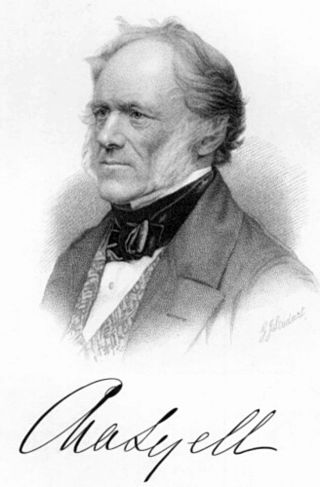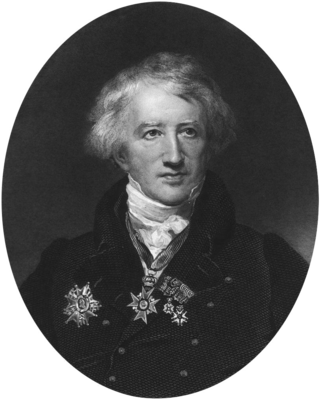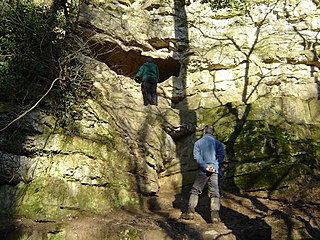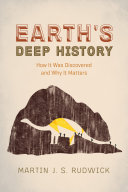Related Research Articles

Sir Charles Lyell, 1st Baronet, was a Scottish geologist who demonstrated the power of known natural causes in explaining the earth's history. He is best known today for his association with Charles Darwin and as the author of Principles of Geology (1830–33), which presented to a wide public audience the idea that the earth was shaped by the same natural processes still in operation today, operating at similar intensities. The philosopher William Whewell dubbed this gradualistic view "uniformitarianism" and contrasted it with catastrophism, which had been championed by Georges Cuvier and was better accepted in Europe. The combination of evidence and eloquence in Principles convinced a wide range of readers of the significance of "deep time" for understanding the earth and environment.

The Devonian is a geologic period and system of the Paleozoic era during the Phanerozoic eon, spanning 60.3 million years from the end of the preceding Silurian period at 419.2 million years ago (Ma), to the beginning of the succeeding Carboniferous period at 358.9 Ma. It is named after Devon, South West England, where rocks from this period were first studied.

Paleontology, also spelled palaeontology or palæontology, is the scientific study of life that existed prior to the start of the Holocene epoch. It includes the study of fossils to classify organisms and study their interactions with each other and their environments. Paleontological observations have been documented as far back as the 5th century BC. The science became established in the 18th century as a result of Georges Cuvier's work on comparative anatomy, and developed rapidly in the 19th century. The term has been used since 1822 formed from Greek παλαιός, ὄν, and λόγος.

Mary Anning was an English fossil collector, dealer, and palaeontologist. She became known internationally for her discoveries in Jurassic marine fossil beds in the cliffs along the English Channel at Lyme Regis in the county of Dorset, Southwest England. Anning's findings contributed to changes in scientific thinking about prehistoric life and the history of the Earth.

Jean Léopold Nicolas Frédéric, Baron Cuvier, known as Georges Cuvier, was a French naturalist and zoologist, sometimes referred to as the "founding father of paleontology". Cuvier was a major figure in natural sciences research in the early 19th century and was instrumental in establishing the fields of comparative anatomy and paleontology through his work in comparing living animals with fossils.

In geology, catastrophism is the theory that the Earth has largely been shaped by sudden, short-lived, violent events, possibly worldwide in scope. This contrasts with uniformitarianism, according to which slow incremental changes, such as erosion, brought about all the Earth's geological features. The proponents of uniformitarianism held that the present was "the key to the past", and that all geological processes throughout the past resembled those that can be observed today. Since the 19th-century disputes between catastrophists and uniformitarians, a more inclusive and integrated view of geologic events has developed, in which the scientific consensus accepts that some catastrophic events occurred in the geologic past, but regards these as explicable as extreme examples of natural processes which can occur.

Timeline of paleontology

Sir Roderick Impey Murchison, 1st Baronet, was a Scottish geologist who served as director-general of the British Geological Survey from 1855 until his death in 1871. He is noted for investigating and describing the Silurian, Devonian and Permian systems.

William Buckland DD, FRS was an English theologian who became Dean of Westminster. He was also a geologist and palaeontologist.
The year 1834 in science and technology involved some significant events, listed below.
The year 1840 in science and technology involved some significant events, listed below.
The Great Devonian Controversy began in 1834 when Roderick Murchison disagreed with Henry De la Beche as to the dating of certain petrified plants found in coals in the Greywacke stratum in North Devon, England. De La Beche was claiming that since Carboniferous fossils were found deep in the Greywacke stratum, which itself was older than the Carboniferous period, this method of dating rocks was not valid. Murchison, in contrast, claimed that De La Beche had not placed the fossils correctly, as they were occurring quite near the top of the stratum as opposed to deep within it. De La Beche soon agreed with Murchison's argument as to the placing of fossils but maintained that since a layer of Old Red Sandstone, present in other formations, was missing between the layer of older rock and this new formation, there was still insufficient evidence to suggest the formation was not part of the older Silurian strata.

Kirkdale Cave is a cave and fossil site located in Kirkdale near Kirkbymoorside in the Vale of Pickering, North Yorkshire, England. It was discovered by workmen in 1821, and found to contain fossilized bones of a variety of mammals not currently found in Great Britain, including hippopotamuses, elephants and cave hyenas.

The history of paleontology traces the history of the effort to understand the history of life on Earth by studying the fossil record left behind by living organisms. Since it is concerned with understanding living organisms of the past, paleontology can be considered to be a field of biology, but its historical development has been closely tied to geology and the effort to understand the history of Earth itself.

Principles of Geology: Being an Attempt to Explain the Former Changes of the Earth's Surface, by Reference to Causes Now in Operation is a book by the Scottish geologist Charles Lyell that was first published in 3 volumes from 1830 to 1833. Lyell used the theory of uniformitarianism to describe how the Earth's surface was changing over time. This theory was in direct contrast to the geological theory of catastrophism.
Scriptural geologists were a heterogeneous group of writers in the early nineteenth century, who claimed "the primacy of literalistic biblical exegesis" and a short Young Earth time-scale. Their views were marginalised and ignored by the scientific community of their time. They "had much the same relationship to 'philosophical' geologists as their indirect descendants, the twentieth-century creationists." Paul Wood describes them as "mostly Anglican evangelicals" with "no institutional focus and little sense of commonality". They generally lacked any background in geology, and had little influence even in church circles.

Duria Antiquior, a more ancient Dorset, was the first pictorial representation of a scene of prehistoric life based on evidence from fossil reconstructions, a genre now known as paleoart.

Phascolotherium is a genus of extinct eutriconodont mammal from the Middle Jurassic of the United Kingdom. Found in the Stonesfield Slate, it was one of the first Mesozoic mammals ever found and described, although like the other mammal jaws found at the same time, it was mistakenly thought at first to be a marsupial.
Jules de Christol was a French paleontologist and geologist who identified the fossil horse ancestor Hipparion. He was among the first French zoologists to suggest the existence of human remains that were "antediluvian", older than the supposed Biblical flood, contrary to the dominant view of Earth history at the time.

Earth's Deep History is a 2014 book by historian and geologist Martin J. S. Rudwick about advances in geological time and deep history, a term for the development of Earth's history and the distant past of the human species. Reviews were largely positive although some criticized Rudwick's minimalism in relation to the conflict between science and religion and the rejection of evolution by religious groups.
References
- ↑ Cambridge University (7 December 2004). "HPS: Martin Rudwick". Archived from the original on 14 July 2009. Retrieved 29 December 2007.
- ↑ University of California, San Diego. "People". Archived from the original on 20 July 2011. Retrieved 29 December 2007.
- ↑ History of Science Society. "History of Science Society - The Society". Archived from the original on 12 November 2008. Retrieved 19 November 2007.
- ↑ Paul Voosen, "Historians of Science Seek Accommodation with Their Subject", Chronicle of Higher Education , May 27, 2014.
- ↑ "Professor Martin Rudwick". Fellows. The British Academy. Retrieved 14 July 2016.
- ↑ Waterhouse, Bruce (1971). "review of Living and Fossil Brachiopods by M. J. S. Rudwick". Science. 171 (3977): 1233–1234. doi:10.1126/science.171.3977.1233.b.
- ↑ Oldroyd, David R. (1985). "An Episode in Geology: The Great Devonian Controversy. The Shaping of Scientific Knowledge Among Gentlemanly Specialists by Martin J. S. Rudwick". Science. 230 (4724): 432–433. doi:10.1126/science.230.4724.432. PMID 17816071.
- ↑ Morrell, J.B. (1987). "review of The Great Devonian Controversy: The Shaping of Scientific Knowledge Among Gentlemanly Specialists by Martin J.S. Rudwick". The British Journal for the History of Science. 20: 88–89. doi:10.1017/S0007087400000583.
- ↑ Gillmor, Stewart (1987). "review of The Great Devonian Controversy: The Shaping of Scientific Knowledge Among Gentlemanly Specialists". Eos, Transactions American Geophysical Union. 68 (52): 1811. Bibcode:1987EOSTr..68.1811G. doi:10.1029/EO068i052p01811.
- ↑ Greene, Mott T. (1994). "review of Scenes from Deep Time: Early Pictorial Representations of the Prehistoric World by Martin J. S. Rudwick". Isis. 85 (4): 709–711. doi:10.1086/357029.
- ↑ Taquet, Philippe (2 April 1998). "Review of Georges Cuvier, Fossil Bones, and Geological Catastrophes by Martin J. S. Rudwick". Nature. 392 (6675): 453–454.
- ↑ Cadée, Gerhard C. (2006). "review of Lyell and Darwin, geologists: Studies in the earth sciences in the Age of Reform by Martin J. S. Rudwick". Archives of Natural History. 33: 183–184. doi:10.3366/anh.2006.33.1.183.
- ↑ Moorbath, Stephen (6 April 2006). "Review of Bursting the Limits of Time by Martin J. S. Rudwick". Nature. 440 (7085): 743. doi: 10.1038/440743a .
- ↑ Baker, Victor R. (24 July 2008). "Review of Worlds Before Adam by Martin J. S. Rudwick". Nature. 454 (7203): 406–407. doi: 10.1038/454406b .
- ↑ Rudwick, Martin J. S. (15 October 2014). Earth's Deep History: How It Was Discovered and Why It Matters. University of Chicago Press. ISBN 9780226204093.